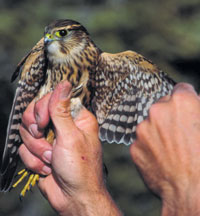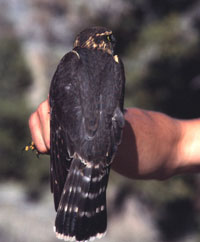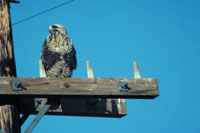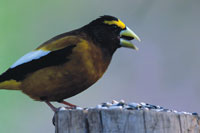Winter is a season of movement. Just like people who seek warmer climates, birds do the same. However, not all birds head for the tropics south of the border. Some find the winter cold of southeastern Utah to be just perfect.
Three winter species that come from northern latitudes to winter in the Moab area are the merlin, the rough-legged and the evening grosbeak. The first two are raptors and the grosbeak is a colorful songbird with a very stout beak.
The merlin is one of five falcon species that haunts the Moab Valley. Similar in size to an American kestrel, the merlin is darker than its close relative is. Whereas the kestrel’s flight is often buoyant and light, the merlin zips across the sky as if shot from a gun. Merlins are the Harley Davidsons of the avian world.
Like their larger relatives the peregrine falcons, merlins also hunt on the wing. They use speed and surprise to run down (fly down?) birds in flight or to explode upon a flock of birds, seeking one of the slower members. To show their hunting prowess, merlins catch dragonflies in flight during the falcon’s migration.
Merlins breed in some of the northern western states and up into the boreal forests of Alaska and Canada. They move south of the breeding grounds in winter and may show up in any western state or southern states from Texas to Florida.
Another bird of prey that winters in the Moab vicinity is the rough-legged hawk. Similar in size and shape to the red-tailed hawk, this buteo or soaring hawk breeds in the northern boreal forests and on the tundra from Alaska to Newfoundland. They prey on small mammals, particularly lemmings, during the breeding season. But in winter, the entire population of hawks moves south to find prey.
Again, this southern migration doesn’t mean that all the birds winter in the tropics. They may be observed across many western and northern states, and cause a stir if they wander into any southeastern ones.
The rough-leggeds are birds of open country. In the Moab area that means these birds may be found in the open grasslands of the Cisco Desert or agricultural areas in San Juan County. In these open areas the birds hunt for small or mid-sized mammals. Like many other hawks, these birds might be spotted perched on a fence post or telephone pole. Thes elevated perches provide the hawks with a better vantage point to locate prey.
Named for their feathered legs, rough-leggeds come in different color morphs – light and dark. Immatures and adult females of the light morph sport a light colored head and chest with a dark “vest” across its belly. Although a bit harder to see on the dark birds, both morphs have dark patches on the undersides of the wings. These “carpal patches” are located near the wrist, the last bend in the wing before the tip.
Contrary to these birds of prey is the evening grosbeak, another bird of winter. Named for their large, not ugly or gross, beak, these songbirds migrate in irregular patterns each winter. Some winters they are scarce. Other winters the birds are abundant.
Often found in large, noisy flocks, the grosbeaks may descend to feast at bird feeders or to pry pine seeds from cones. Large white wing patches offset the male’s mustard-colored back and eyebrow line. Their occurrence is a winter special.
If you are in need of a New Year’s resolution how about this one: I plan to go or start birding more often. Painless and possible. After all, an estimated 50 million people in the United States feed or watch birds for a hobby. And out of the 100 or so species of birds that winter in the Moab area, these three would make a good start to your 2010 bird life list. And that would be one New Year’s resolution that would be fun to keep.




